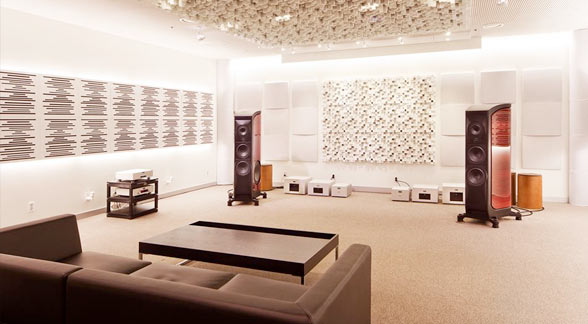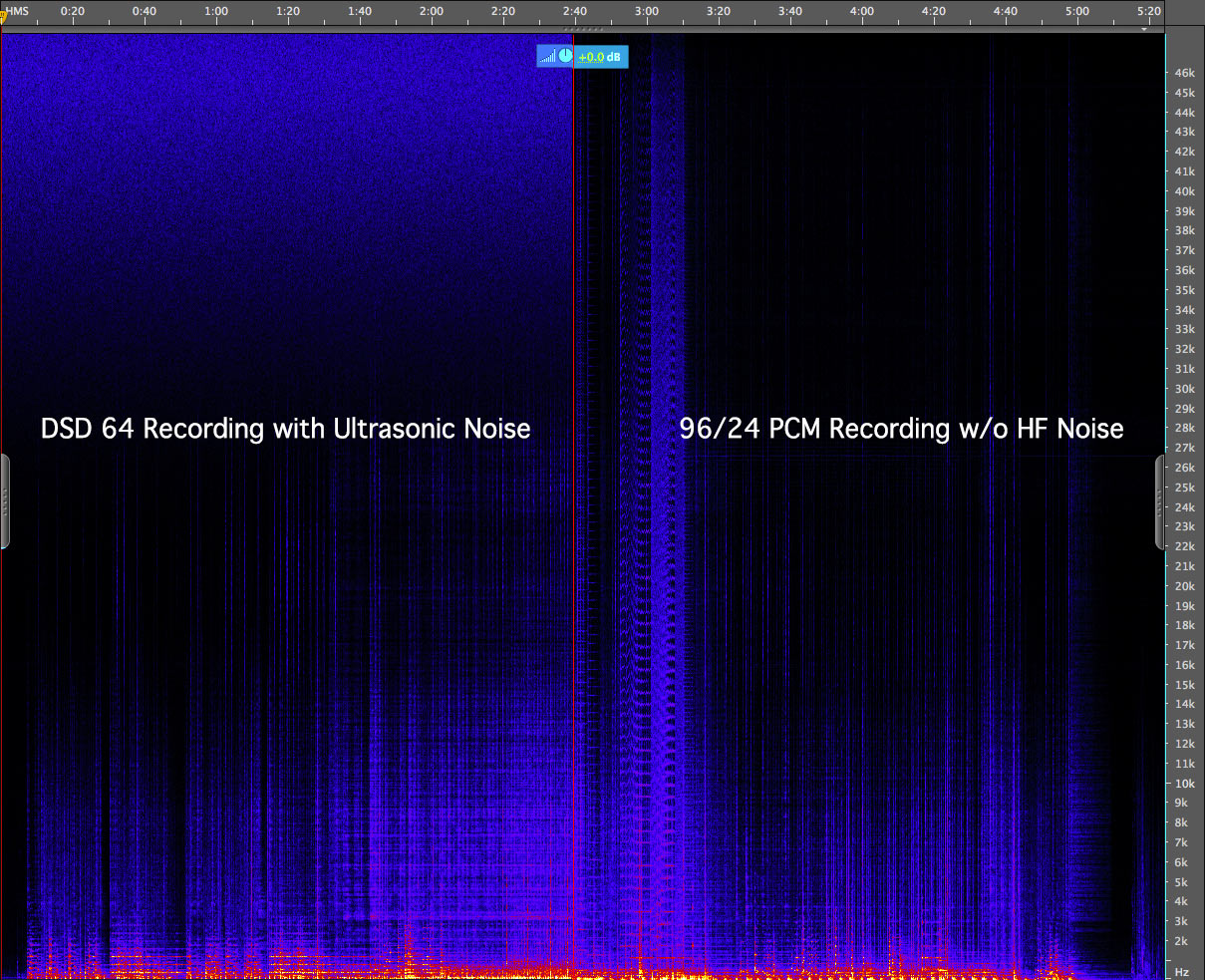DSD in 7 Minutes
As I said yesterday, thanks to my friendship with Jim Merod of BluPort Records and the generosity of Dr. David Robinson of Positive Feedback Online, I was allowed to contribute my thoughts on DSD during the T.H.E. Show Newport Beach session entitled “DSD Downloads From The Studio To Your Home”.
Jim, of course, knows that I’m not an advocate of the format for production OR distribution. In the few minutes that I held the floor from the back of the seminar room, I focused on a few carefully researched items.
The first is the complete lack of production tools that are available to work natively in the format. DSD was originally developed by Sony and Phillips as an archiving format. They never intended DSD, in any multiple, to be used by recording engineers to do new productions. Once the SA-CD format was launched, the engineering teams realized that DSD as a native 1-bit system was incapable of being used like the DAW (Digital Audio Workstations) for any postproduction work. You couldn’t mix, you couldn’t edit, and you couldn’t modify the timbre or dynamics of a 1-bit stream. Jared Sacks from Channel Classics confirmed that in his videotape presentation during the DSD session on Saturday. He moves to DXD whenever he needs to do postproduction work on his native recordings.
Instead, the production flow in DSD requires a different approach. The Sonoma DSD multichannel recorder can be used as a simple recording deck with great quality analog to digital and digital analog converters on the front and back. This means that the engineers simply capture the output of the ADC during the sessions. To do any of the post processing, they send the DSD DAC signal to a large analog console. There are lots of classic and modern consoles that have wonderful equalizers and dynamics processors as well as faders to adjust the sound. If reverberation is needed (and it usually is for jazz and commercial releases), for example, then the analog signals are sent to PCM-based signal processors, reconverted to analog and mixed into the final stereo mix.
A second alternative involves converting the DSD 1-bit native streams into DXD. It turns out that there are lots of well-developed tools for DXD. You can change the equalization, modify the dynamics, edit and normalize in DXD quite easily. DXD is simply another name for High Definition PCM! This version of PCM runs at 352.8 kHz and captures 24 or 32 bit words. It is one of the highest resolution recording formats on the planet (only 784 kHz/24 or 32-bit PCM is higher). In fact, as I pointed out, my friend Morten Lynberg at 2L uses DXD to record ALL of his projects and then downconverts to 192 Khz/24-bit FLAC or DSD 64. This makes sense to me and I said so at the DSD session. Morten’s methodology represents that third production option.
As I closed my comments, I mentioned the session that I was involved with in Montana. I wrote about that unique opportunity some weeks ago (see post here). Brett Allen, who owns SnowGhost Studios in Whitefish, Montana invited a few select engineers to his studio in late March to do some critical listening and to participate in a comparison between a recording done on analog tape (2″ Studer A827), Sonoma DSD 64 with Meitner conversion and PCM at 96/24 using Mytek conversion. My statement to the assembled Newport crowd highlighted the fact that both the DSD and the HD PCM sounded really wonderful…especially as the amps and speakers were worth more than $250,000 (Wilson and VTL…Peter McGrath and Luke Manley were in attendance)!
However when I looked at the spectragraphs of the mixes done through DSD vs. PCM, I saw the normal pattern of “ultrasonic” noise associated with the DSD plot. The PCM ultrasonics were pristine and showed the expected blackness at 20 kHz and higher. The left side of my brain believes this is problematic and makes DSD unusable…and I’m not alone in my position. I mentioned that Jonathan Reichbach, the owner and programmer of Amarra, John Siau of Benchmark, James Tanner of Bryston and Robert Stuart of Meridian agree with this position and have no plans to implement DSD in their products. The advocates of DSD ignore this and focus on their right brain reactions (the emotional/creative half). See the figure below.
Figure 1 – A comparison of the spectra of DSD vs. PCM. Click to enlarge.
There is lots of uncorrelated high frequency noise associated with ALL flavors of DSD. It doesn’t matter whether you use DSD 64, 128 or 256 or whether you “upconvert” standard DSD to higher versions…you will still have noise that must be shifted. It’s true that it can be rolled off leaving the remaining 20-20kHz clean and completely useable. And if capturing and reproducing sound above 20 kHz is meaningless, then DSD can be a wonderful format.
But for someone interested in expanding the realism of audio recording by maximizing both the dynamic range and frequency response of a recording, DSD is a non-starter. I prefer a methodology that lacks the noise and inaccuracies of DSD… and I’m not alone.



I enjoy your Dr Aix emails and I just discovered there is a comments facility — it is too far down the page.
The DSD issue is certainly an interesting one, because the hi-fi consumer audiophile forums are these days are filled with discussion of DSD and how so many audiophiles believe it is the best available format for pure sound quality. There are some real devotees out there.
What I find interesting, being a home hi-fi multichannel nut with SACD playback capability, is how very tricky it can be to preserve a true, or pure, DSD chain if that is one’s wish. Things can change to PCM without you really knowing it. Take the popular Oppo players for instance. The player can be set to DSD output when playing SACD disks, and the analog outputs will be filtered one-bit without PCM conversion, which might be the ideal for a DSD fan. But if the poor fellow should connect a monitor to the player through the HDMI outputs, the analog outputs will change to PCM DAC even when playing an SACD disk. Who would’ve thought?
And then there are the AVR playback units. Some of these – not many – have a DAC that that is capable of switching to filtered one-bit analog when a DSD signal is detected. I have a Yamaha unit that does this. However, the consumer would have to be quite savvy to realise that the vast majority or perhaps all of the internal DSP processing of the unit would involve a necessary conversion to PCM. The receiver itself doesn’t tell you which decision it is making, and one needs to pour over datasheets even to form a hypothesis.
It is all rather tricky and barely worth the trouble, although I think most audiophiles would be blithely unaware of what is really happening to their lovely DSD signal on its way to the loudspeaker. Interesting, don’t you think?
I have been making limited trial of DSD downloads from Blue Coast Records, 2L, and a few others. I have been mightily impressed with the sound quality of the Blue Coast productions, but not really with any of the others. Most of the others sound similar to other high resolution PCM files I have. I was initially very enthusiastic about DSD downloads, but that has been based largely on my experience with the Blue Coast files. To be honest, the files they offer and indicate as originally recorded in PCM are also impressive. Might it be the case that Cookie Marenco is just a much better recording engineer than most others and that is why I am impressed with their product? My experience is that music recording is a typical human endeavor and the quality of it can be represented on a bell curve: most recordings are average and an equally small number are excellent or execrable. Given the large number of variables and steps involved in bringing a recording to final production, the opportunity for spoling the music is large. Maybe Cookie Marenco is just better able to control the production process and that is why her recordings are wonderful, whether they be in DSD or PCM.
Barry, Cookie is certainly a skilled engineer and producer and has recorded many wonderful sounding tracks…using analog tape and PCM. As I understand her current production methodology, she recorded initially to analog tape and then converts to DSD for delivery.
As I have stated here more than once, the production philosophy of any individual engineer is their “art” and is not a simple procedure. I’ve spent more than 35 years crafting my own recording sound and technique. It is less about PCM vs DSD than the skills and preferences of the people involved in putting things together.
Your ears should be the ultimate judge.